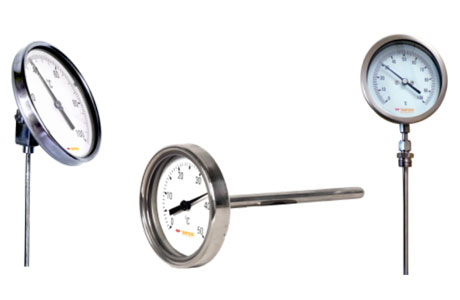What Are Explosion-Proof Temperature Switches?
Key Takeaway
Explosion-proof temperature switches are designed to operate in hazardous environments with flammable gases or dust. They have rugged housings that prevent sparks or heat from escaping and causing explosions.
These switches are widely used in oil and gas, chemical, and mining industries to ensure safe operations in explosive atmospheres.
Introduction to Explosion-Proof Devices
Explosion-proof devices, including explosion-proof temperature switches, play a critical role in protecting systems and equipment in hazardous environments where the risk of explosions is prevalent. These devices are specially engineered to withstand explosive atmospheres and prevent sparks or heat from igniting potentially combustible substances. Explosion-proof temperature switches are essential in industries such as oil and gas, chemical manufacturing, and mining, where volatile gases and flammable materials are present.
The primary purpose of these switches is to provide a safe means of regulating temperature without the risk of sparking or causing ignition in environments where safety is paramount. Let’s delve deeper into how these switches are designed and the vital role they play in ensuring operational safety.

Design Features of Explosion-Proof Temperature Switches
Explosion-proof temperature switches are built with design features that allow them to operate safely in high-risk areas. These switches are designed to prevent any electrical sparks or heat generated from the internal workings of the switch from igniting any explosive atmosphere in their vicinity.
Key design elements include:
1. Sealed Enclosures: Explosion-proof temperature switches are housed in specially sealed enclosures that prevent the escape of sparks or heat. These enclosures are often made of durable materials such as stainless steel or cast aluminum, which provide resistance against harsh environments.
2. Explosion-Proof Wiring: The wiring inside these switches is designed to be explosion-proof, preventing any short circuits from leading to ignition. This feature is critical in environments with a high risk of flammable gases or liquids.
3. Explosion Containment: Many explosion-proof switches are designed to contain an internal explosion within the enclosure, allowing the switch to function even if an internal failure occurs without posing a risk to the environment.
4. Rugged Construction: These switches are also designed to be highly durable, capable of withstanding physical impact and vibration, which makes them suitable for challenging industrial settings.
Applications in Hazardous Environments
Explosion-proof temperature switches are essential in industries where volatile substances are present, and the risk of explosions is high. These switches ensure that equipment operates within safe temperature ranges without sparking or causing fires. Some of the most common applications include:
1. Oil and Gas: In the oil and gas industry, explosive gases and vapors are common. Explosion-proof temperature switches are used in drilling rigs, refineries, and gas processing plants to monitor and regulate equipment temperature safely.
2. Chemical Manufacturing: Chemical plants often deal with flammable chemicals, and explosion-proof temperature switches help ensure that equipment such as reactors and storage tanks are kept at safe operating temperatures.
3. Mining: In underground mining operations, the presence of flammable dust or gases makes explosion-proof temperature switches essential to prevent equipment malfunctions that could lead to disastrous explosions.
4. Pharmaceutical and Food Processing: These industries also rely on explosion-proof devices to regulate temperature in areas where volatile substances or chemicals may be present.
Standards and Certifications for Safety
Explosion-proof temperature switches must comply with rigorous safety standards to ensure they are suitable for use in hazardous environments. Various regulatory bodies and organizations set these standards to guarantee the protection of both personnel and property. Some key standards include:
1. ATEX (Atmosphères Explosibles): In the European Union, the ATEX directive outlines the safety requirements for equipment used in explosive atmospheres. Explosion-proof temperature switches must meet the requirements of ATEX to be certified for use in such areas.
2. IECEx (International Electrotechnical Commission Explosive): IECEx is an international certification system for equipment used in explosive atmospheres. Explosion-proof temperature switches must adhere to IECEx standards for use in countries around the world.
3. UL (Underwriters Laboratories): In the United States, UL certifications ensure that explosion-proof switches meet specific safety criteria to prevent ignition in hazardous locations.
4. FM (Factory Mutual) Approval: FM approval is another common certification for explosion-proof devices, ensuring that the switches are designed and manufactured to prevent ignition in hazardous environments.
These standards and certifications ensure that explosion-proof temperature switches can be trusted to perform safely and reliably in high-risk environments.
Benefits of Using Explosion-Proof Switches
Using explosion-proof temperature switches in hazardous environments offers numerous benefits, including:
1. Enhanced Safety: The primary benefit is increased safety. These switches prevent ignition by containing sparks, heat, or any other potential sources of explosion, ensuring that workers and equipment are protected from hazardous accidents.
2. Regulatory Compliance: Explosion-proof temperature switches ensure compliance with industry regulations and safety standards, helping organizations avoid costly penalties and maintain safe operating conditions.
3. Reliability and Durability: Designed for demanding environments, explosion-proof temperature switches are built to withstand harsh conditions, including extreme temperatures, physical impact, and vibration. This durability ensures long-term performance and reduces the need for frequent replacements.
4. Cost Efficiency: By preventing costly accidents, downtime, or damage to equipment, explosion-proof temperature switches help organizations save money in the long run. They also reduce the risk of product loss or damage, which can be especially costly in sensitive industries like pharmaceuticals or chemicals.
5. Versatility: Explosion-proof temperature switches can be used in a wide range of industries and applications, from heavy industrial sectors to more specialized fields, ensuring their versatility in hazardous locations.
Conclusion
In conclusion, explosion-proof temperature switches are designed to operate safely in hazardous environments where flammable gases or dust are present. These switches prevent ignition sources, ensuring safety in critical applications.
The development of explosion-proof switches highlights the commitment to safety in high-risk industries. As regulations tighten, demand for such specialized equipment is expected to grow, driving innovation in both design and functionality to meet evolving safety standards.

